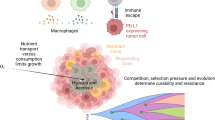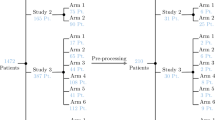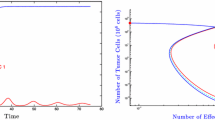Abstract
Precision medicine employs intricate statistical methods to evaluate relationships between patient profiles and fundamental clinically driven outcomes. Most notably in immunotherapy, precision medicine technologies have enabled revolutionary advances in oncology, particularly in immunotherapy. Mathematical modeling of the dynamic interactions between the patient’s disease and the pharmacological system presents an alternate approach to therapy personalization. In addition, mathematical models may help us better comprehend tumor evolution and the dynamics of cancer, the immune system, and the short- and long-term applications of chemotherapy and immunotherapy. Compared to economics, engineering, and physics, the application of mathematical models has been reasonably limited. In cancer, it is increasingly acknowledged that mathematical modeling is crucial for generating experimental and clinically testable hypotheses and directing study design. A mathematical model reduces biological complexity to a manageable representation that is complicated enough to retain the general qualities of the natural system and sufficiently simple to provide insight that can be utilized to make predictions. Mathematical models can aid in comprehending complicated biological systems by offering approximations and abstractions that can be used to construct testable hypotheses about how biological components evolve and interact to produce a given outcome. While attempting to validate a model, a mathematician typically identifies gaps in biological understanding and calls attention to crucial components that experimental biologists may overlook. This paves the way for future discoveries and raises our understanding of the condition, hence increasing the possibility that successful therapies will be developed.
Similar content being viewed by others
References
Agur Z, Elishmereni M, Forys U, Kogan Y (2020) Accelerating the development of personalized cancer immunotherapy by integrating molecular patients’ profiles with dynamic mathematical models. Clin Pharmacol Ther 108:515–527
Bocharov G, Ford NJ, Ludewig B (2005) A mathematical approach for optimizing dendritic cell-based immunotherapy. Methods Mol Med 109:19–34
Charoentong P, Angelova M, Efremova M, Gallasch R, Hackl H, Galon J, Trajanoski Z (2012) Bioinformatics for cancer immunology and immunotherapy. Cancer Immunol Immunother 61:1885–1903
De Pillis LG, Radunskaya AE (2012) Best practices in mathematical modeling. Methods Mol Biol 929:51–74
Gallasch R, Efremova M, Charoentong P, Hackl H, Trajanoski Z (2013) Mathematical models for translational and clinical oncology. J Clin Bioinforma 3:23
Rockne RC, Hawkins-Daarud A, Swanson KR, Sluka JP, Glazier JA, Macklin P, Hormuth DA, Jarrett AM, Lima E, Tinsley Oden J, Biros G, Yankeelov TE, Curtius K, Al Bakir I, Wodarz D, Komarova N, Aparicio L, Bordyuh M, Rabadan R, Finley SD, Enderling H, Caudell J, Moros EG, Anderson ARA, Gatenby RA, Kaznatcheev A, Jeavons P, Krishnan N, Pelesko J, Wadhwa RR, Yoon N, Nichol D, Marusyk A, Hinczewski M, Scott JG (2019) The 2019 mathematical oncology roadmap. Phys Biol 16:041005
Serre R, Benzekry S, Padovani L, Meille C, Andre N, Ciccolini J, Barlesi F, Muracciole X, Barbolosi D (2016) Mathematical modeling of cancer immunotherapy and its synergy with radiotherapy. Cancer Res 76:4931–4940
Spring BQ, Lang RT, Kercher EM, Rizvi I, Wenham RM, Conejo-Garcia JR, Hasan T, Gatenby RA, Enderling H (2019) Illuminating the numbers: integrating mathematical models to optimize photomedicine dosimetry and combination therapies. Front Phys 7
Valle PA, Coria LN, Salazar Y (2019) Tumor clearance analysis on a cancer chemo-immunotherapy mathematical model. Bull Math Biol 81:4144–4173
Victori P, Buffa FM (2019) The many faces of mathematical modelling in oncology. Br J Radiol 92:20180856
Walker R, Enderling H (2016) From concept to clinic: mathematically informed immunotherapy. Curr Probl Cancer 40:68–83
Wilkie KP (2013) A review of mathematical models of cancer-immune interactions in the context of tumor dormancy. Adv Exp Med Biol 734:201–234
Author information
Authors and Affiliations
Editor information
Editors and Affiliations
Rights and permissions
Copyright information
© 2022 Springer Nature Switzerland AG
About this entry
Cite this entry
Bertolaccini, L., Bardoni, C., Spaggiari, L. (2022). Mathematical Models in Immuno-Oncology. In: Rezaei, N. (eds) Handbook of Cancer and Immunology. Springer, Cham. https://doi.org/10.1007/978-3-030-80962-1_312-1
Download citation
DOI: https://doi.org/10.1007/978-3-030-80962-1_312-1
Received:
Accepted:
Published:
Publisher Name: Springer, Cham
Print ISBN: 978-3-030-80962-1
Online ISBN: 978-3-030-80962-1
eBook Packages: Springer Reference Biomedicine and Life SciencesReference Module Biomedical and Life Sciences




